![]()
![]()
![]()
Use LEFT and RIGHT arrow keys to navigate between flashcards;
Use UP and DOWN arrow keys to flip the card;
H to show hint;
A reads text to speech;
294 Cards in this Set
- Front
- Back
- 3rd side (hint)
|
Portal vein |
Low velocity continous flow toward liver with mild undulation |
|
|
|
Portal triad |
Mpv Common hepatic duct Hepatic proper artery |
|
|
|
Hepatic blood flow |
25% proper hepatic artery 75% portal vein |
|
|
|
Hepatic o2 |
50% portal vein 50% proper hepatic artery |
|
|
|
Portal vein diameter |
13 mm |
|
|
|
Hepatic veins |
Hepatofugal-toward IVC Triphasic -above and below the baseline Above -atrial contraction blood goes back to the liver |
|
|
|
Hepatic proper artery runs |
Parallell to the main portal vein |
|
|
|
Proper hepatic artery gives |
Rt and lt hepatic arteries 55% of time |
|
|
|
Sometimes the rt hepatic artery may come from |
SMA (Seen posterior to mpv and panc head) |
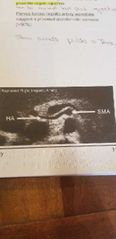
|
|
|
Sometimes the lt hepatic artery may originate from |
Lt gastric artery |
|
|
|
Hepatic artery waveform |
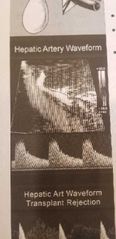
Low resistance |
|
|
|
High resistance hepatic artery means |
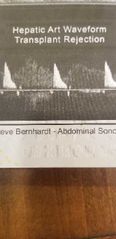
Organ rejection |
|
|
|
Tardus parvus hepatic artery |
Proximal stenosis |
|
|
|
Ligamentum teres |
Remnant of umbilical vein extending from umbilicus to lt portal vein |
|
|
|
Falciform ligament |
Peritoneal fold from passage of umbilical vein from umbilicus to lt portal vein |
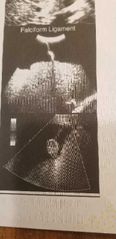
|
|
|
Hepatomegaly |
Greater than 15.5 cm |
|
|
|
If labs are normal |
You do not have hepatomegaly |
|
|
|
Echogenicity from hyper to hypo |
Renal sinus Pancreas Spleen/liver Renal cortex |
|
|
|
Sonolucent |
Anechoic |
|
|
|
Granulomas |
Calcification in spleen/liver |
|
|
|
Cause of granulomas |
Histoplasmosis Tuberculosis |
|
|
|
Hepatitis may result in |
Elevated ALT,AST, bilirubin |
|
|
|
Hep A |
Fecal oral route |
|
|
|
Hep b and c |
Blood/body fluids |
|
|
|
Acute hepatitis |
Hypoechoic Enlarged liver Hyperechoic portal vein walls |
|
|
|
Chronic hepatitis |
Hyperechoic liver Small liver |
|
|
|
Most comon cause of liver pyogenic abscess |
Biliary tract disease |
|
|
|
What lobe is affected more from pyogenic abcesses |
Rt lobe |
|
|
|
Sono findings of pyogenic abcess |
Complex mass Gas Reverb artifact |
|
|
|
Clinical findings of abscess |
Pain, fever , leukocytosis |
|
|
|
3 types of liver abcess |
Pyogenic-most common Amebic Fungal |
|
|
|
Pyogenic vs amebic |
If pt has traveled outside of US Choose amebic |
|
|
|
Fungal abscess |

Candidiasis Can have different appearances based on time Wheel within a wheel-early most recognizable Bulls eye hypo or hyper with calc |
|
|
|
Treatment for echinocholal cysts |
Leave it alone and monitor Rupture or aspiration is associated with anaphylaxis shock |
|
|
|
Echinochocal cysts |
Hydatid disease |
|
|
|
Echinochocal cysts |
Hydatid disease |
|
|
|
Schistosomiasis |
Most common parasitic infections in humans |
|
|
|
Schistosomiasis causes |
Periportal fibrosis resulting in portal hypertension |
|
|
|
Schistosomiasis us |
Occluded intrahepatic portal veins Thick portal vein walls Signs of portal hypertension |
|
|
|
Major cause of portal hypertension |
Schistosomiasis |
|
|
|
Most common cause of cirrhosis in western world |
Hep c |
|
|
|
Focal sparing |
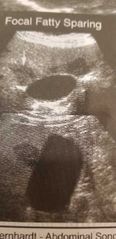
Happen next to GB-do not measure |
|
|
|
Focal fatty infiltration |
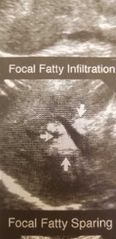
Happens at porta hepatis-hyperechoic areas |
|
|
|
Glycogen storage disease |
Accumulation of glycogen in liver |
|
|
|
GSD is associated with |
Fatty infiltration Adenomas Von gierkes disease |
|
|
|
Cirrhosis |
Diffuse process of fibrosis and distorted normal liver architecture |
|
|
|
Causes of cirrhosis |
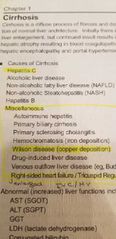
|
|
|
|
Cirrhosis lab values |
Increased AST ALT GGT LDH conjugated bilirubin |
|
|
|
Cirrhosis US |
Hepatomegaly acute Liver atrophy-chronic Caudate enlargment Surface nodularity Fatty infiltration Portal hypertension risk of HCC |
|
|
|
If pt has cirrhosis/hep c |
Check liver well for HCC |
|
|
|
Normal pressure in portal vein |
5-10mmHg-higher than IVC |
|
|
|
Most common cause of portal hypertension |
Cirrhosis |
|
|
|
Portal hypertension is |
Asymptomatic |
|
|
|
Portal hypertension presentation clinically |
GI hemorrage Spit blood or rectal bleeding |
|
|
|
Secondary us sign of portal hypertension |
Splenomegaly ascites Collaterals |
|
|
|
Correction of portal hypertension |
TIPS portocaval shunts Linton shunts Warren shunts |
|
|
|
Linton shunt |
Splenorenal -normal to se hepatofugal |
|
|
|
Warren shunt |
Distal splenorenal shunt |
|
|
|
Portal systemic varices |
GE varices Umbilical vein Splenorenal Intestinal Rectal varices |
|
|
|
Physical signs of collaterals |
Caput medusa Hemorroids Ascites |
|
|
|
TIPS |
Trans jugular intrahepatic portosystemic shunt |
|
|
|
TIPS |
Between a hepatic vein and a portal vein usually the rt |
|
|
|
With TIPS |
RPV and LPV should demonstrate hepatofugal flow MPV hepatopedal? |
|
|
|
TIPS MALFUNTION |
Low shunt velocity High focal shunt velocity Absent shunt flow Hepatofugal MPV Hepatopedal RPV/LPV |
|
|
|
Exception to the rule is when there is a recanalized umbilical vein |
Flow in LPV can either be hepatofugal or hepatopedal-rely only in RPV |
|
|
|
Material used for TIPS |
PTFE -cant evaluate in the first 3-5 days (shadows) |
|
|
|
Most common indication for adult liver transplant |
Cirrhosis |
|
|
|
Most common indication for liver transplant in kids |
Biliary atresia |
|
|
|
Postoperatively the hepatic artery |
Provides the only blood supply to the biliary tree Stenosis will cause biliary tree complications |
|
|
|
Cavernous transformation |
Worm like venous collaterals that parallel the chronically thrombosed portal vein Typically seen with benign causes of portal vein thrombosis |
|
|
|
Most common benign cause of portal vein thrombosis |
Cirrhosis/hepatitis |
|
|
|
Causes of portal vein thrombosis |
Cancer-liver,mets,pancreas Hypercoagulation Splenectomy Pancreatitis Trauma Cirrhosis |
|
|
|
Portal vein thrombosis us |
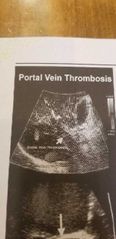
Thrombus in pv Dilated pv Cavernous transformation Collaterals |
|
|
|
Portal vein gas is |
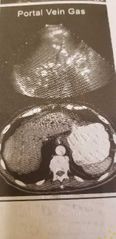
A medical emergency |
|
|
|
Hemorragic liver cysts |
Ruq pain Decreasing hematocrit |
|
|
|
Most common benign tumor of the liver |
Cavernous hemangiomas |
|
|
|
Cavernous hemangiomas |
Usually hyperechoic (hypo if fatty liver) Posterior enhancement Color doppler does not usually show flow May enlarge with estrogen |
|
|
|
Hemangiomas |
Multiple vessels |
|
|
|
Focal nodular hyperplasia |
Localized overgrowth of hepatocytes |
|
|
|
FNH |
Stealth lessions Produces mass effect by displacing intrahepatic vessels |
|
|
|
Hepatic adenomas associated with |
Pills GSD |
|
|
|
Hepatic adenomas must be resected |
Due to their risk of malignant transformation |
|
|
|
Hepatic lipoma show |
Speed artifact |
|
|
|
Sound speed in tissue |
1540 |
|
|
|
Sound speed in fat |
1450m/s Objects posterior to a fatty mass will be seen more posterior-slow return time |
|
|
|
HCC |
Most common primary malignancy of liver |
|
|
|
HCC |
Single mass or diffuse growth thats hard to see |
|
|
|
HCC lab values |
Increased AFP AST ALT |
|
|
|
Hepatoblastoma |
Malignant kids |
|
|
|
Hepatoblastoma usually |
Before 2 y/old |
|
|
|
Infantile hemangioendothelioma |
Benign tumor in neonatals May undergo regression |
|
|
|
Hepatoma |
HCC |
|
|
|
When is AFP elevated |
HCC/HEPATOMA LIVER METS HEPATOBLASTOMA germ cell tumors-testis and ovaries |
|
|
|
IRN |
Calculated from PT |
|
|
|
Normal IRN in absence of blood thinners |
0.8-1.2 |
|
|
|
PT normal range |
12-13 seconds |
|
|
|
Gallblader is located at |
Inferior end of main lobar fissure |
|
|
|
Porta hepatis |
Proper hepatic artery Main portal vein Common hepatic duct |
|
|
|
Cystic artery comes off from |
Rt hepatic artery |
|
|
|
Valves of Heister |
Spiral fold in prox cystic duct |
|
|
|
Hartman pouch |
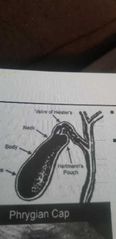
Diverticulum of the neck |
|
|
|
Phrygian cap |
Fold between body and fundus |
|
|
|
Junctional fold |
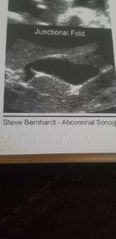
Between neck and body |
|
|
|
Cbd passes |
Posterior to first part of duodenum and pancreatic head to join the panc duct at ampulla of vater |
|
|
|
Most common cause of gb wall thickening |
Cholecystitis |
|
|
|
We cannot eval cholecystitis in presence of |
Ascites |
|
|
|
Causes of GB wall thickening |
Cholecystitis Ascites Congestive Heart failure Pancreatitis Hepatitis Hypoalbuminemia
|
|
|
|
Causes of jaundice |
Pre hepatic Hepatic Post hepatic |
|
|
|
Pre heaptic jaundice |
To much hemolysis Excessive RBC break down -to much bilirubin to be processed by liver unconjugated hyperbilirubinemia |
|
|
|
Hepatic jaundice |
Liver disease that impedes liver to conjugate bilirubin |
|
|
|
Post hepatic jaundice |
Obstruction of biliary tree Causing conjugated bilirubinemia |
|
|
|
Conjugated hyperbilirubinemia or biliary obstruction |
Pale stool Dark urine |
|
|
|
Biliary obstruction |
Choledocholethiasis Mirizzi syndrome Choledocal cysts Caroli disease Biliary atresia Cholangitis Pancreatic cancer GB cancer |
|
|
|
Sludge |
Echogenic material Nonshadowing Layers Shifts with change in position |
|
|
|
Sludge is |
Calcium +cholesterol |
|
|
|
Sludge causes |
Bile stasis TPN or fasting Hemolysis Cholecytitis Cystic duct obstruction |
|
|
|
Tumefactive sludge |
Thick sludge that may mimic a GB mass |
|
|
|
Cholelithiasis |
Mobile Shadowing Strongly echogenic |
|
|
|
Gallstones are composed of |
Cholesterol Calcium |
|
|
|
Cystic duct obstruction may result in |
Acute cholecystitis Empyema GB perforation Abcess Bile peritonitis |
|
|
|
GB filled with stones |

WES sign-wall echo shadow |
|
|
|
Murphy sign |
Acute cholecystitis |
|
|
|
Acute cholecystitis |
GB inflamation due to a stone in cystic duct |
|
|
|
Acute cholecystitis clinical signs |
RUQ pain/murphy sign Fever Leukocytosis |
|
|
|
Acute cholecystitis US |
Gallstones Sludge Wall thickening-diffuse Gb dilatation Pericholecystic fluid |
|
|
|
Acute cholecystitis |
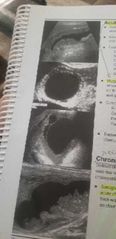
|
|
|
|
Chronic cholecystitis |
Does not look different from acute Clinicak diagnosis if its repetitive |
|
|
|
Emphysematous cholecystitis |
Acute cholecystitis due to wall ischemia and infection |
|
|
|
Emphysematous cholecystitis |
Common in diabetic pt-narrow of cystic artery |
|
|
|
Emphysematous cholecystitis |
High perforation rate-emergency |
|
|
|
Emphysematous cholecystitis |
Gas in gb wall/lumen/biliary tree Ring down artifact Dirty shadow Champagne sign |
|
|
|
Emphyema of GB |
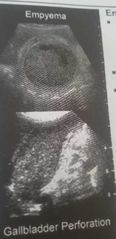
Acute cholecystitis (cystic duct obstruction) in presence of bile with bacteria Pus in gb |
|
|
|
GB perforation |
Rare If u dont see the GB Fluid in fossa |
|
|
|
Acalculous cholecystitis |
Usually in hospitalized pt after surgery |
|
|
|
Milk of calcium bile |

Sludge with a high concentration of of calcium |
|
|
|
Milk of calcium bile |
Limy bile Shadows |
|
|
|
Porcelain GB |
Calcifications of GB wall associated with chronic cholecystitis |
|
|
|
Porcelain GB |
Assoc with cancer |
|
|
|
Hydrops |
Impacted stone in neck/cystic duct |
|
|
|
GB polyps are cancerous if |
More than 10 mm in diameter |
|
|
|
Cholesterolosis |
lipids deposit in GB wall |
|
|
|
Cholesterolosis |

Strawberry GB |
|
|
|
Cholesterolosis |
Silent Or colicky abd pain |
|
|
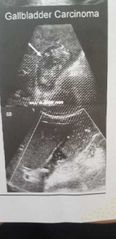
GB carcinoma |
Less than 50% are discovered before surgery;most post surgery |
|
|
|
Adenomyomatosis |
Hyperplastic changes of gb wall Thickening and diverticula |
|
|
|
Adenomyomatosis |
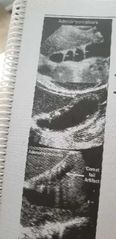
Diverticula in gb wall accumulate stones/sludge within them giving comet tail artifact |
|
|
|
Biliary obstruction causes |
Gallstones Pancreatic head cancer |
|
|
|
Biliary obstruction is considered clinically |
When pt presents with jaunice |
|
|
|
Lab values for biliary obstruction |
Elevated ALP CONJUGATED BILIRUBIN GGT |
|
|
|
When distal CBD is obstructed |
Extrahepatic and intrahepatic ducts dilate too |
|
|
|
CBD commonly measured |
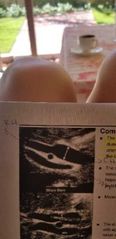
When the rt hepatic artery courses between common hepatic duct and the MPV |
|
|
|
Dilated CBD |
More or equal to 8mm |
|
|
|
CBD Upper limit in eldery pt |
10 mm |
|
|
|
Rate of increase of CBD |
One mm per decade |
|
|
|
Post cholecystectomy CBD upper limit |
10 mm |
|
|
|
Shotgun sign/paralel chanel sign |
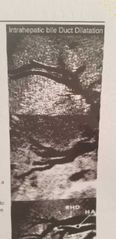
Dilated intrahepatic ducts |
|
|
|
Causes of intrahepatic ducts only |
Cholangiocarcinoma Caroli disease Pyogenic cholangitis Intrahepatic choledocholithiasis |
|
|
|
Cholecystokinin |
Causes GB contraction |
|
|
|
Administer a fatty meal with +results |
Duct increase in size (they should decrease because they will release the bile) |
|
|
|
Administer fatty meal -results |
Unchanged or decrease in size -happens normally |
|
|
|
The part of biliary tree that dilates depend on |
Level of obstruction |
|
|
|
Distal CBD obstruction |
Every thing dilates including GB |
|
|
|
Common hepatic duct obstruction |
Common hepatic duct dilated intrahepatic ducts dilated GB will be contracted-no bile |
|
|
|
Junction of rt and lt hepatic ducts obstruction |
Intrahepatic ducts dilatation GB contracted |
|
|
|
Choledocholithiasis |
Most common cause of extrahepatic obstructive jaundice |
|
|
|
Choledocholithiasis |
Jaundice RUQ pain |
|
|
|
Lab for choledocholithiasis |
Elevated ALP GGT conjugated bilirubin |
|
|
|
Mirizzi syndrome |
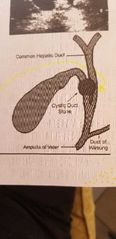
Stone in cystic duct Causes compression of common hepatic duct |
|
|
|
Mirizzi syndrome US |
Intrahepatic ducts dilated Stone in cystic duct Compressed CHD |
|
|
|
Cholangiocarcinoma |
Bile duct cancer |
|
|
|
Precursor of cholangiocarcinoma |
Primary sclerosing cholangitis |
|
|
|
Most common finding of cholangiocarcinoma |
Intrahepatic ducts dilatation |
|
|
|
Cholangiocarcinoma |
Originate in extrahepatic bile ducts (CHD/CBD) |
|
|
|
Klatsin tumor |
Originates at junction of rt and lt hepatic duct Results in intrahepatic ducts dilatation only |
|
|
|
Cholangitis |
Inflamation of biliary tree |
|
|
|
Cholangitis |
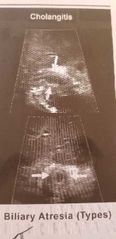
Bile duct wall thickening |
|
|
|
Charcot triad of cholangitis |
RUQ pain Fever Jaundice |
|
|
|
Most common cause of cholangitis |
Choledocholithiasis |
|
|
|
Other causes of cholangitis |
ERCP obstructive tumors( pancreatic,ampullary,cholangiocarcinoma) |
|
|
|
Cholangitis may result in |
Cirrhosis Portal hypertension Sepsis |
|
|
|
Biliary atresia |
Absence of extrahepatic ducts Have GB |
|
|
|
Extrahepatic ducts |
CHD CBD |
|
|
|
Biliary atresia is suspected when |
Jaundice (hyperbilirubinema) persists beyond 14 days of age |
|
|
|
Biliary atresia US |
Triangular cord sign Anterior to portal vein |
|
|
|
Biliary atresia associated with |
Polysplenia |
|
|
|
Treatment for biliary atresia |
Kasai portoenterostomy (KPE) liver transplant also considered |
|
|
|
Pneumobilia |
Air in biliary tree |
|
|
|
Causes of pneumobilia |
ERCP-most common Emphysematous cholecystitis Surgery |
|
|
|
Choledocal cyst |
Congenial Cystic dilatation of extrahepatic ducts CBD dilatation is most common |
|
|
|
Choledochal cyst US |
2 cystic structures-Gb and dilated CBD Intrahepatic duct dilatation |
|
|
|
Choledochal cyst |
Common in asia Before 10 symptoms |
|
|
|
Caroli disease |
Similar to choledochal cyst Type 5 choledochal cysts |
|
|
|
Caroli disease |
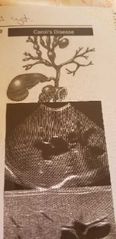
Affects intrahepatic bile ducts |
|
|
|
Caroli disease |
Sludge and stones may accumulate in the dilated parts |
|
|
|
Most common malignant neoplasm that cause biliary obstruction |
Pancreatic adenocarcinoma |
|
|
|
Courvoisier GB |
Distended non diseased GB due to mechanical obstruction of CBD |
|
|
|
Double duct sign |
Dilated CBD and pancreatic duct From adenocarcinoma Ca or stone in ampulla of vater |
|
|
|
Primary sclerosing cholangitis |
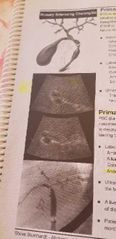
Inflamation and fibrosis of intra and extrahepatic bile ducts
Like cirrosis |
|
|
|
Primary sclerosing cholangitis assoc |
HCC cholangiocarcinoma Colorectal cancer Inflammatory bowel disease |
|
|
|
Primary biliary cholangitis |
Same as cirrhosis- autoimmune |
|
|
|
Hallmark for primary biliary cholangitis |
antimitochondrial antibodies |
|
|
|
Bilirubin |
End product of hemoglobin break down ( spleen) |
|
|
|
Bilirubin is conjugated by |
Liver |
|
|
|
Bilirubin conjugation |
Liver removes albumin from bilirubin making it soluble |
|
|
|
Conjugated bilirubin is |
Water soluble and can be filtered by kidneys if there is excess
|
|
|
|
Bilirubin in urine means |
Conjugated hyperbilirubinemia (Bile flow obstruction) |
|
|
|
ALP |
Alkaline phosphatase found in bile ducts-bone liver placenta Increases with every bile duct obstruction |
|
|
|
Panc head is |
Anterior to IVC |
|
|
|
Panc head is |
Medial to duodenum |
|
|
|
CBD is |
Postero lateral to head of panc |
|
|
|
GDA is |
Antero lateral to panc head |
|
|
|
SMA SMV are |
Posterior to the neck of panc Anterior to uncinate procces |
|
|
|
Panc tail is |
Ant and medial to splenic hilum |
|
|
|
Duodenum has 4 portions |
1 and 3 trv 2 and 4 sag |
|
|
|
Panc duct can be dilated from |
Stone in panc duct from chronic pancreatitis Stone in ampulla of vater |
|
|
|
3 ducts drain in |
Second portion of duodenum |
|
|
|
Cystic fibrosis |
Causes thick secretions |
|
|
|
Cystic fibrosis |
Pancreatic issues meconium ileus-no first stool: too thick |
|
|
|
Most common cause of hyperechoic pancreas in kids |
Cystic fibrosis |
|
|
|
Pancreatic true cysts |
Are rare |
|
|
|
Chronic pancreatitis |
Alcohol Cystic fibrosis Autoimmune Hereditary Trauma |
|
|
|
Chronic pancreatitis US |
Small echogenic gland Dilated panc duct with calc Dilated bile duct Pseudocysts Portal vein thrombosis |
|
|
|
Acute pancreatitis US |
Enlarged Hypoechoic gland |
|
|
|
Acute pancreatitis directions |
Resolve Pseudocyst Chronic |
|
|
|
Complications of acute pancreatitis |
Pseudocysts Thrombosis Hemorrage Abscess Pseudoaneyrism Panc necrosis |
|
|
|
When dealing with pancreatitis check |
Vessels for thrombosis |
|
|
|
Pancreatic phlegmon |
Focal pancreatitis Compl of acute pancreatitis |
|
|
|
Most common cause of acute pancreatitis |
Gallstones Alcohol |
|
|
|
Lipase |
Later longer |
|
|
|
Amylase |
First to rise First to go down |
|
|
|
Islet cell tumors |
Endocrine tumors |
|
|
|
Islet cell tumor are associated with |
MEN VHL |
|
|
|
Islet cell tumors |
Insulinoma Gastrinoma Glucagonoma Vipoma etc |
|
|
|
Insulinomas |
Most common islet cell tumor |
|
|
|
Insulinomas |
Usually benign |
|
|
|
Insulinomas |
Hypogycemia Hyperinsulinemia |
|
|
|
Gastrinomas |
Usually malignant |
|
|
|
Gastrinomas |
2nd most common |
|
|
|
Pancreatic islet cell tumor usually located |
Body/tail Except insulinomas/gastrinomas |
|
|
|
MEN |
Inhereted endocrine disorder that affects Thyroid Parathyroid Pancreas islet cells Adrenals |
|
|
|
MEN |
Multiple endocrine neoplasia |
|
|
|
Pancreatic serous cystadenoma |
Benign Assoc with VHL May be echogenic mass if small cysts |
|
|
|
Mucinous cystic neoplasms |

Most common cystic mass of pancreas Malignant -in body/tail Elevated CEA and CA 19 -9 |
|
|
|
Pancreatic divisum results in |
Pancreatitis Smaller santorini duct drainig the pancreas -not enough |
|
|
|
Most common cause of panc pseudocysts in kids is |
Trauma-check for bruises child abuse |
|
|
|
Pancreas is located in |
Anterior pararenal space |
|
|
|
Panc pseudocysts contain |
Amylase lipase trypsin |
|
|
|
Pseudocyst are more common in |
Lesser sac Tail |
|
|
|
Pancreatic adenocarcinoma labs |
Lipase Amylase GGT alkaline phosphatase Conjugated bilirubin |
|
|
|
Adrenal gland is |
Superomedial to kidney |
|
|
|
Liver is superolateral to |
Rt kidney |
|
|
|
Spleen is |
Superior to lt kidney |
|
|
|
Pancreatic tail is anterior to |
Lt kidney upper pole |
|
|
|
Diaphragm is |
Posterior to kidneys |
|
|
|
Psoas/quadratus lumborus muscle are |
Posterior to kidneys |
|
|
|
Order at the hilum of kidney |
Vein-ant Artery Ureter -post |
|
|
|
Renal cortex |
Normal 1 or more than 1 cm |
|
|
|
Renal artery |
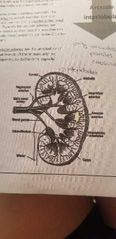
Main renal artery Segmental Interlobar Arcuate Interlobular |
|
|
|
Renal artery that runs parallel to renal capsule |
Arcuate artery |
|
|
|
Horshoe kidneys are found lower in abdomen because |
IMA prevents them from ascending |
|
|
|
Most common fusion anomaly |
Horseshoe kidney |
|
|
|
In cross fused kidneys |
One ureter crosses the midline to implant into the right position in bladder |
|
|
|
Dromedary hump |
Chortical thickening in lt kidney lateral aspect |
|
|
|
Junctional parenchymal defect |
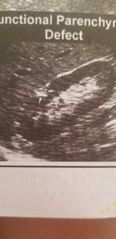
Upper pole of rt kidney |
|
|
|
Duplex kidney |
Duplication of collecting system Complete Incomplete |
|
|
|
Complete duplex kidney |
2 ureters |
|
|
|
Incomplete duplex kidney |
One ureter |
|
|
|
Complete duplex kidney results in |
Hydroureter Hydronephrosis of upper pole |
|
|
|
Abcess vs hemorragic cyst |
Presence of air in abscess Aspiration if no air present |
|
|
|
ADPKD |
Multiple renal cysts (20-30y/o) |
|
|
|
ADPKD associated with |
Cysts in other organs Arterial aneurysms-berry |
|
|
|
ARPKD |
echogenic enlarged kidneys |
|
|
|
Most common cause of abdominal mass in newborn |
Multicustic dysplastic kindeys |
|
|
|
MDK |
Usually unilateral The other kidney works harder Multiple cysts |
|
|
|
Nephrocalcinosis |
Calcium salt depostits in renal parenchyma |
|
|
|
Most common cause of nephrocalcinosis |
Primary hyperparathyroidism |
|
|
|
Papillary necrosis |
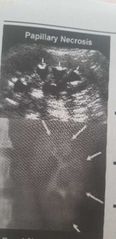
Necrosis of papilla and renal pyramids |
|
|
|
Tuberous sclerosis is asocc with |
Renal cysts Angiomyolypoma -bilateral |
|
|
|
Von hippel lindau disease is assoc with |
Kidneys Adrenal Pancreas tumors/cysts |
|
|
|
Most common presenting symptom of RCC |
Hematuria |
|
|
|
RCC |
Adenocarcinoma Hypernephroma |
|
|
|
Renal oncocytoma |
Usually benign |
|
|
|
Most common childhood renal tumor |
Wilm (3 years) |
|
|
|
Is associated with beckwith weidemann syndrome |
Wilms tumor |
|
|
|
Most common renal tumor in neonates |
Mesoblastic nephroma Can be begnin and malignant |
|
|
|
Acute pyelonephritis |
Bacterial invasion of renal parenchyma |
|
|
|
Acute pyelonephritis |
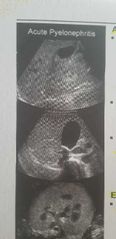
Large hypoechoic kidneys with no sinus echos |
|
|
|
Focal acute pyelonephritis |
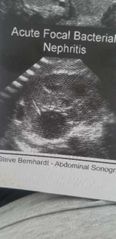
Lobar nephronia Acute focal bacterial nephritis |
|
|
|
Ephysemateous pyelonephritis |
Bacterial infection that causes renal ischemia-needs surgery to remove the kidney DM Reverb |
|
|
|
Chronic pyelonephritis |
Small echogenic kidneys |
|
|
|
Xgpn pyelonephritis |
Type of chronic pyelonephritis usually from staghorn calculi |
|
|
|
Pyonephrosis |
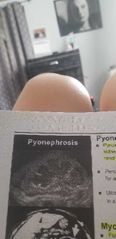
Pus in dilated renal collecting system |
|
|
|
Myectoma |

Fungal ball -candidasis |
|
|
|
Myectoma vs angiomyolipoma |
If they have infection pick myectoma If tuberous sclerosis pick angiomyolipoma |
|

